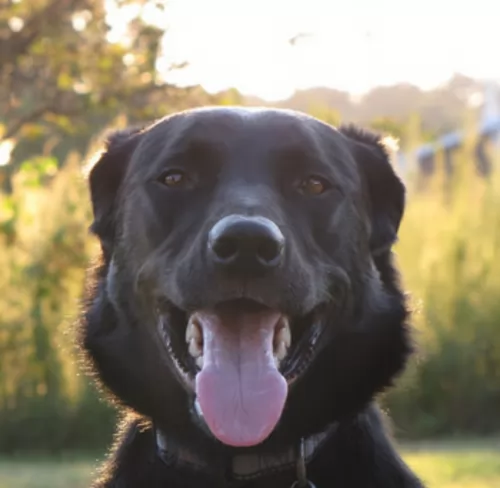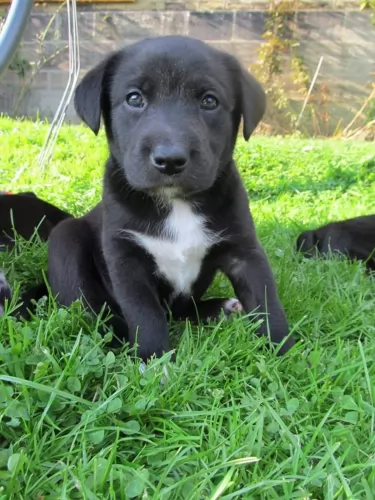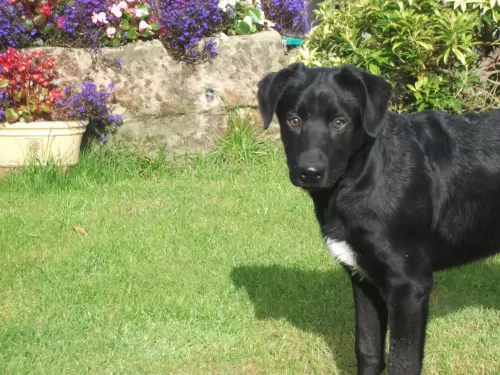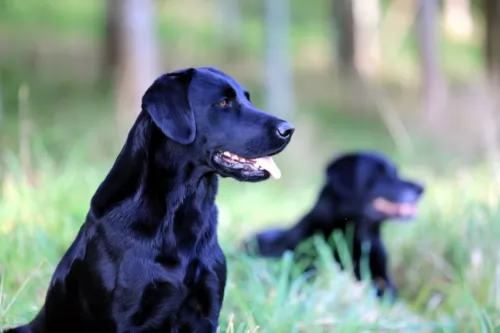 MyDogBreeds
MyDogBreedsSerbian Mountain Hound is originated from Serbia but Borador is originated from United States. Serbian Mountain Hound may grow 7 cm / 2 inches shorter than Borador. Both Serbian Mountain Hound and Borador are having almost same weight. Serbian Mountain Hound may live 3 years less than Borador. Both Serbian Mountain Hound and Borador has almost same litter size. Serbian Mountain Hound requires Low maintenance. But Borador requires Moderate maintenance
Known as the Srpski Planinski Gonic dog and coming from Yugoslavia, the Serbian Mountain Hound is one of two modern hounds that was once known as the Yugoslavian Mountain Hound or Jugoslovenski Planinski Gonic.
There isn't much information on the origins of the dogs. These two dogs are considered similar breeds, only varying in region. Its a hunting dog thought to have descended from Asian search dogs.
 Hybrid breeds have become popular in the last decade or so. The Borador, hailing from Northern America, is one of these popular crossbreeds between two very popular dog breeds - the Border Collie and the Labrador Retriever. Between the two dog breeds, you get extraordinary intelligence, energy and a wonderful temperament.
Hybrid breeds have become popular in the last decade or so. The Borador, hailing from Northern America, is one of these popular crossbreeds between two very popular dog breeds - the Border Collie and the Labrador Retriever. Between the two dog breeds, you get extraordinary intelligence, energy and a wonderful temperament.
You first started hearing about this dog breed in the early 21st century. However each of the two breeds brought together to produce the Borador have got reasonable lengthy histories.
The Serbian Mountain Hound is about 46 to 50cm in height and weighs around 18 to 22 kilograms. This Yugoslavian hound breed has been used in Serbia as a hunting dog and they are thought to be rare outside of Serbia.
The coat of the newer Mountain Hound is fairly short and thick and mainly black with some tan marks around the paws and muzzle. The dog has floppy ears and a long tail.
This is a hardy scent hound that is confident and bold. They are used to hunting on rough terrain in the Balkan region. They are independent dogs and training and socialization will refine them, making the dog obedient and well mannered.
When he isn’t outdoors, he becomes a good-natured, gentle amiable dog that is good with children in the home.
 The Borador is a medium to large sized working dog which is well well-proportioned and muscular. His size can’t be carved in stone, but generally he will be in size from 40 – 57cm and weight in the region of 18 and 26 kg. His coat can vary significantly, leaning more towards one particular breed than the other. So the coat can be short and smooth or long and wavy or straight.
The Borador is a medium to large sized working dog which is well well-proportioned and muscular. His size can’t be carved in stone, but generally he will be in size from 40 – 57cm and weight in the region of 18 and 26 kg. His coat can vary significantly, leaning more towards one particular breed than the other. So the coat can be short and smooth or long and wavy or straight.
The Borador essentially has medium-sized ears which are floppy and the tail is medium-length. Sometimes the Borador will have the black and white coat of the Border Collie or he could have a brownish/beige colour from a golden Labrador.
When your energetic Borador is trained and socialized, he becomes a great family member and he gets on well with children and other pets.You’ll find that he often has the sweet, amicable temperament of the Labrador while having the sharp, alert intellect of the Border Collie.
Most Boradors are also good watchdogs and will bark at strangers, but because they are so amicable, from barking, they can quickly become a stranger’s friend.
The Serbian Mountain Hound is such a social, happy, friendly kind of dog that he makes a wonderful family pet.
He learns well, he likes to please, he gets on well with children and dogs in the home, he is independent and not a noisy barker. He is also fairly low maintenance.
Take good care of him and you’re guaranteed to have a wonderful pet and companion.
 The Borador is an intelligent dog that can be trained. He is a sociable dog and is friendly to all members of his human family, willing to extend a paw of friendship to strangers as well.
The Borador is an intelligent dog that can be trained. He is a sociable dog and is friendly to all members of his human family, willing to extend a paw of friendship to strangers as well.
The Borador is also a friend of children and other pets. This combination of breeds is very energetic and you can’t just leave him for days on end in the backyard. He will need exercise and walks as well as ball games. When you become involved in his games, you tighten the bond between you and this is what this social, outgoing dog loves.
The Borador is going to make a wonderful pet because he is a mix of two very popular dog breeds. Give him all he deserves as a member of your family and you’ll have the perfect friend and companion for life.
Nobody wants their dog to be sick and lethargic, after all they are our best friend’s. Some ways to check the status of your dog’s health -
Check his breath, as a bad breath, just like as with a human being, can be a sign of illness. It can also be indicative of dental problems, digestive or kidney problems.
Spread his fur and check that the skin is a healthy color – pink, grey or black. Make sure there is no crusting or itching with red, inflamed areas. Make sure the coat is thick and lustrous – not falling out and thinning.
Make sure the nails aren’t split, flaking and broken and that the paws aren’t cut so that the dog is constantly licking them.
Every dog drinks a lot of water after hectic exercise, but if your dog suddenly becomes very thirsty more than usual, it could be indicating a medical problem, and you will need to discuss it with your vet.
 You won’t find serious health problems with your Boradors, as he is a robust breed. Nonetheless, there are some ailments that as a dog owner, you need to be aware of for your Borador.
You won’t find serious health problems with your Boradors, as he is a robust breed. Nonetheless, there are some ailments that as a dog owner, you need to be aware of for your Borador.
Skin ailments – you don’t want to see your dog scratching or licking continuously so you want to be aware of things like parasites and allergies. Skin diseases can be debilitating for a dog and can even require lifelong treatments. Yes, corticosteroids can help with itchy rashes, but the best move is to try and avoid skin ailments by ensuring a nutritious diet rich in minerals and vitamins and which includes some raw meat.
Always be checking your pet for skin problems such as ringworm, caused by a fungus and found on your dog and which appear as scaly patches and hair loss.
Hip Dysplasia – an inherited problem with the hip joints. No-one can predict when hip dysplasia settles in, but it can be as early as 4 months of age.Your dog shows signs of stiffness and may not be his energetic self. Some dog owners want to see certificates first that the parents of puppies have been hip-cleared before they buy a puppy.
 The Borador may have inherited the moderate shedder characteristics of the Border Collie or the more intense shedding of the Labrador Retriever. He will require a good brush at least twice a week to ensure you remove loose hairs so as to keep his coat shiny and healthy. Check your dogs ears too for yeast infections.
The Borador may have inherited the moderate shedder characteristics of the Border Collie or the more intense shedding of the Labrador Retriever. He will require a good brush at least twice a week to ensure you remove loose hairs so as to keep his coat shiny and healthy. Check your dogs ears too for yeast infections.
Puppies and young Boradors are full of energy and they will require a diet that has an excellent protein content. If you’re unsure about how to feed your Borador, speak to your vet as some dogs need more calories depending on their level of activity.
Certainly if your dog has allergies, you may have to look for a special diet but otherwise a top brand commercial dog food can be a good choice if you include some home prepared food such as rice, vegetables and meat. It is important to give your dog some raw meat every now and then as well. Always have a bowl of cool, fresh water available for your pet 24/7.